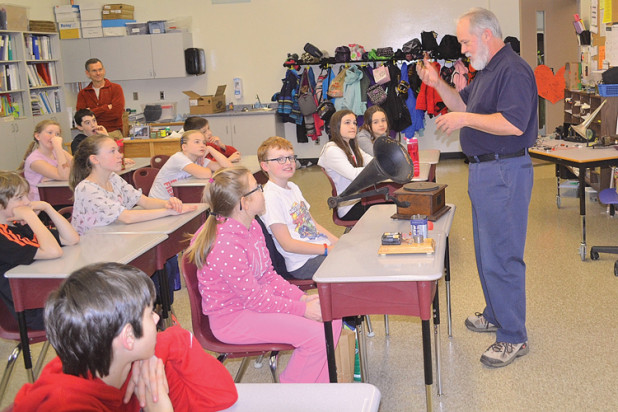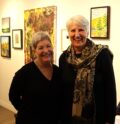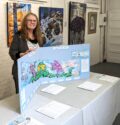General News
Old equipment builds bridges between past and present
February 18, 2016

Jim Eadie, local journalist and member of the International Morse Telegraphers Association, demonstrates an old phonograph – the same one as on the old RCA Victor label – to Rob Metzger’s Grade 6 class at Birds Creek Public School. TONY PEARSON Special to This Week
By Tony Pearson
In an age of phones that do everything but make you breakfast, it seems amazing that a roomful of tech-savvy kids would sit enraptured around century-old equipment that requires you to learn a language of dots and dashes. And when even CDs are now obsolete, giving way to Bluetooth and other personal music platforms, it is truly astonishing that these same kids would listen raptly to sounds emerging from a horn that looks like it belongs in the kitchen.
But that’s what happens when Jim Eadie rolls out his boxes of antique tech at area schools. Last week, he was in Rob Metzger’s Grade 6 class at Birds Creek Public School, where they are studying a unit on electricity.
As Metzger notes, it’s a big change to put down your I-Pod and listen to a phonograph that has to be wound up by a hand crank, as it plays two minutes of fuzzy band music from a tinfoil cylinder. Then there’s the opportunity to watch a telegraph send out Morse code. Metzger’s students know about the process from Eric Walters’ books on Canada’s Camp X, the spy-training school during the Second World War. But it’s another level of experience to hear the dit-dot-dits echo out to create a message, at a speed nearly as fast as a person can talk.
Eadie traces the lines and bridges that connect the old equipment to today’s techniques. He outlines how the telegraph was able to connect cities. A writer for Bancroft This Week, Eadie demonstrated a 1920s era reporter’s telegraph box, whereby he could file a news story from miles away in “real time.”
He shows the foundation of today’s world in the old technology. For example, he points out that the undersea telegraph cables were the first “worldwide web,” and notes that Morse code is binary, just like today’s computers (if a slight bit slower).
Eadie remembers the time his youthful interest was sparked when he recovered a discarded short-wave radio. “I could see the dials pointing out cities all over the globe. A fire started to burn in me to understand the process, and to use it myself. Now I get excited when I look into the bright eyes of today’s students, and see the same lights turning on, as they soak up the information and make the connections. They really get it.”
Teacher Metzger observes the fun the students have seeing and using the old equipment, which brings the abstract lesson to life. “It is always worthwhile,” he reports, “any time we can do hands on activities and use a local expert to bring learning alive.”

















